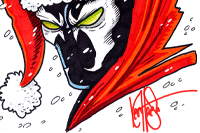SIMON SPURRIER
 SEND THIS TO A FRIEND! SEND THIS TO A FRIEND!
DF Interview: Simon Spurrier unveils a new epic fantasy series with ‘A Mischief of Magpies’ By Byron Brewer Mar has a secret. Sometimes, without warning, he falls out of the world. This would be an inconvenience if his life wasn't already such a drag. When he's gone, he finds himself in an extraordinary city. A city which is also a machine, endlessly crossing a shoreless ocean. A city of two halves: the bright, bustling spires above the waves, and the beast-haunted twilight halls below. And between, clowning along the rusting beach, a troupe of anarchic magpies with all the answers but none of the questions. Recipients of the Angoulême Sélection Officielle, GLAAD Award, and multiple Eisner Award nominations, creators Simon Spurrier and Matías Bergara present a new fantasy masterpiece in the tradition of Coda and Step By Bloody Step in A Mischief of Magpies, driving the comics medium into new, beautiful, baleful waters. Before I knew it, I was talking to my old friend, scribe Si Spurrier. Here’s what he told me. Byron Brewer: Si, with this new book A Mischief of Magpies, you said you and your fellow creators were “aiming for nothing less than a paradigm shift in the possibilities of the comic book form”. Can you explain how that is executed in the book and what that means for both creator AND reader? Simon Spurrier: A few years back, Matias and I made Step By Bloody Step. That project grew out of a simple but somewhat perverse question we posed to ourselves. Is it possible to tell a complex, emotionally resonant story without using a single piece of language? I think the answer -- to our surprise as much as anyone’s -- was a resounding Yes. We learned a ton during that process, but among the more granular lessons was a bigger takeaway. We’re at our best when we challenge ourselves. It wasn’t long before we were scheming over our next experiment, and it felt right to pivot as far as possible. We started thinking about text. About language. About the unsung roles of letterer and designer in the roster of comicbook collaborators. We’ve all read stories which switch between forms. Comics with prose interludes, picturebook novels with limited stripwork masquerading as spot illustrations. Many of them are soaringly beautiful, some are clunky and awkward. In either case, we’ve always felt there’s a jarring changing-of-gears required when reading these books. A breaking of the flow, as the reader’s mind adjusts from the received information of imagery, to the perceived information of text. Some readers are quite happy to endure these shifts; others find them hard work. How many folks skipped the text-heavy parts of Watchmen until their second readthrough? How many of those Krakoa-era data pages never got seen? So… we set ourselves the challenge of overcoming that hurdle. We wanted to weave a fusion that’s so liquid, so organic, that the reader barely notices the transitions. That’s what we’re referring to when we waffle about pushing the medium, extending the storytelling possibilities. The best thing is that comics were halfway there already: there is no other form which melds the received and the perceived so magically and so effortlessly. This is fertile ground to plant brainseeds. What’s emerged is a story centered around diaries. At its core is the therapy-journal of a troubled teenager, who undergoes a series of extraordinary adventures in an impossible alternate world, all while trying to get his proverbial s**t together. He keeps falling out of reality into a fantastical realm of machines, monsters and magic. His recollections of these disappearances are part narrative, part travelogue, part self-analysis. He’s trying to figure out what’s happening to him and why. His words flow not only into the laptop he’s typing on, but through the adventures themselves. His innermost thoughts become more than just recordings, they interact and interfere with events. And along the way he encounters other forms of extra-natural text, from the whispering voices of a magical mirror to the godlike instructions inscribed by a sacred quill, to the chattering analysis of a restless supercomputer. It’s too fiddly a topic to get into here with any brevity – the film students among your readers will be nodding sagely right now – but in essence we’re toying with the theory of diegesis: playing fast-and-loose with what it means for storytelling elements to exist “in world” or outside of it. …And if all of the above sounds waaaay too pompous and pretentious to be the sort of thought-process you’d expect to find behind a beautiful, fast-paced, heart-stirring fantasy romp, then here’s the good news: it works. It works invisibly. Matias’ art breathes weird beauty into every moment. The combined skills of Hassan Otsmane-Elhaou (letterer) and Emma Price (designer) ensures that the text never feels cold, never feels intrusive. It’s a graphic interface -- every bit as interesting and fantastical as the art it invests. To put it simply: This isn’t a story which merely jumps between pictures and text. It’s a subtle interface between language and spectacle, which mirrors its own subject matter: an awkward, distant young man interfacing with a breathtaking other world. Gears within gears, you see? Byron: What can you tell us about the cosmic canvas you and artist Matias Bergara will be setting us down into come April: a city sailing on a shoreless ocean, built around a machine which has shimmering spires above the waters and a twilight area below them? Simon Spurrier: It’s called the Wandering City. A colossal machine, half above the water, half below. Its gargantuan cogs and thundering pistons are the streets, boulevards and towertops of its residential population. A teeming culture has grown here, full of extraordinary technologies, machine-wildlife and technocratic rituals. Vast firebirds known as The Gilded soar and swoop, intertwining their golden feathers with the machine. And above it all, in the tallest tower, the tireless men and women of the Bright Council plot the city’s course and steer it to safety. This machine-city travels, endlessly, across its watery planet. There are smart reasons for that – fish-stock migrations, mineral dredging, seasonal weather patterns – but below the utilitarianism lies a doctrine which has come to infuse and define everything this civilization does: GO EVER ON. The machine works in order to work. The city moves in order to move. Stopping is unthinkable. And yet, stopping is precisely what’s being threatened. Because below the surface of the sea, amidst the grinding, barnacle-spackled submarine parts of the machine, lives the Moray King. A grim, beautiful, melancholy warlock, master of a thousand toothy beasts and leering serpents, whose one and only goal is to stop the propellers, silence the deafening engines, and bring peace to the dark depths. To sink the city. And this is the world into which Mar Picknett falls. Byron: Introduce readers to Mar: Who was he, who is he now, and what challenge(s) at least initially face him in the scenario life – or something/someone – has put him into? He is said to be young, does his family figure into the story at all? Simon Spurrier: I don’t want to say too much for fear of robbing the heart of the tale. (I’m aware I’ve done my usual Spurrier trick of waxing lengthy with my first couple of answers then becoming increasingly tight-lipped.) But… We meet Mar at various stages of his life -- at his birth, then aged 6, then 12 -- before really settling-in with him when he’s 16. He’s a deep thinker, awkward in his own skin. Badly bullied, but empathetic enough to recognize that the bullies are just as trapped in their own performative little bubbles as he feels in his. There are several changes happening in his life when the story really kicks off. His younger sister is sick, and that’s causing a ton of stress and sadness at home. His parents have simultaneously become emotionally distant yet overanxious, trying to treat their own guilt by medicalizing the problem. Sending him off to therapy. And then a new kid comes to his school -- a girl even more shy and vulnerable than he is -- which stirs everything up and causes him to make a massive fool of himself. It’s here that he first falls into the Wandering City. And everything changes forever. Byron: What other characters are of import in A Mischief of Magpies, as a whole if not in this initial issue #1? Can you spotlight some of them here? Simon Spurrier: I’ve mentioned the main ones, apart from the eponymous magpies. (By the way, a “mischief” really is the preferred collective noun for everyone’s favorite piebald corvid, a la “a murder of crows”, “a parliament of rooks”, “an improbability of puffins”, etc.) The Wandering City, as I’ve said, is divided between upper and lower worlds. Mar struggles to find a place in either. And so he winds up drawn to the shoreline -- the intertidal beaches among rusting machinery -- where he finds a mob of anarchic talking magpies. They live by no rules except loyalty to one another, put down roots only one day at a time, hate the pomposity of the Bright Council and mock the miserable self-importance of the Moray King. They are feckless, irresponsible, roguish and daft. They’re brilliant. Byron: Talk about Matias’ art in Magpies, and about your collaborations with the artist. Simon Spurrier: I think I pretty much covered all this [in the first question]. Classic me, sorry. What I’ll add is that with experimental projects like Step By Bloody Step and Magpies, it’s often daunting to deliberately bend rules and try new things when you’re not in control of every element. Normally, we’d expect this sort of thing to be the preserve of the writer-artist – someone who can do everything themselves. (My mind goes to Joe Sacco, and how effortlessly he dances between storytelling, reportage and cartoon record.) If Matias and I didn’t have the sort of collaborative relationship that only comes up once in a career -- and even then only if you’re lucky -- this stuff simply wouldn’t be possible. We’ve come to trust each other implicitly, and that trust has allowed us to add other spectacular talents to the team, all adroitly overseen by our old Coda editor, Eric Harburn. It’s an overused cliche, but it happens to be true: When everyone’s giving it their all, when the egos are left at the door and the communication is good, we really do become greater than the sum of our parts. Byron: Si, what other projects are you working on that you can tell readers about? Simon Spurrier: Slim pickings here for reportage, I’m afraid. The next arc of The Flash begins in April, that’s called Bad Moon Rising. I think it might be my best yet. If I were looking to tease, I’d say: Imagine hellish World War 1-style trench warfare, on the moon, all happening at superspeed, in which one entire army is composed of thousands upon thousands of timeline-split Wally Wests. Each one born to die. And the other is a million-strong legion of sun demons. It’s epic, it’s grim, it’s chock-full of ideas. It’s very me. What else? I have a new Image book dropping in the summer. I’ve been quite secretive about that so far -- we’ll announce more, including the incredible artist, in due course. But that’s far less of a classic Si Spurrier confection. A very contained, tense, quiet thriller vibe here, with very few genre elements. I love it to bits. The big news I announced at ComicsPro is that I’ve signed up to work on multiple titles with industry newcomers Ignition Press. There’s going to be a lot to say about that over the forthcoming months, not just about the stories themselves but the broader conversation about how IP is doing things differently and what that means for the wider comicsphere. But this isn’t the time or place for that. Dynamic Forces would like to thank Simon Spurrier for taking time out of his busy schedule to answer our questions. A Mischief of Magpies #1 from DSTLRY Comics is slated to be in stores April 16!
NEW! 1. 09/23/2025 - FRANK BARBIERE2. 09/16/2025 - RODNEY BARNES 3. 09/10/2025 - ZACK KAPLAN 4. 08/26/2025 - JOE PRUETT 5. 08/20/2025 - CHRISTIAN WARD Show All |








